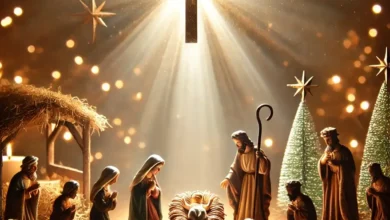
What is the meaning of the Jesse tree in Christianity?
The Jesse Tree helps us journey along the path of fulfilling God’s promises, which were accomplished in Christ, whose birth we celebrate at Christmas—Jesus Christ.
فرست محتوا
What is the Jesse Tree?
The Jesse Tree helps us unite the tradition of decorating Christmas trees with biblical events leading up to the birth of Jesus. The Jesse Tree is inspired by Isaiah 11:1: “A shoot will come up from the stump of Jesse; from his roots a Branch will bear fruit.”
Jesse was the father of King David. We decorate a Jesse Tree with illustrated ornaments symbolizing people, prophecies, and events that occurred before Jesus’ birth. The Jesse Tree ornaments tell God’s story in the Old Testament, connecting the Advent season with God’s faithfulness throughout 4,000 years of history.
Roots and significance of the Jesse Tree
The tradition of the Jesse Tree began in medieval Europe, inspired by Isaiah 11:1, which prophesies a “branch” growing from the “stump of Jesse.” This verse has been interpreted as a reference to Christ, who would come from the line of David. The earliest depictions of the Jesse Tree appeared in illuminated manuscripts, stained glass windows, and other forms of art.
For Christians, the Jesse Tree holds great meaning during Advent. It serves as a visual reminder of God’s faithfulness throughout history and His promise of salvation through the lineage of King David. As we gradually decorate the tree, we prepare for the celebration of Christmas, marking the arrival of Jesus and the fulfillment of God’s promises.
Jesse Tree practice during Advent
During Advent, a new ornament is added to the Jesse Tree each day, along with a reading related to the corresponding Old Testament symbol. This practice helps Christians connect with the history of salvation and prepare their hearts for the celebration of Christmas.
The Jesse Tree serves as a visual reminder of God’s faithfulness throughout history and His promise of salvation through the line of King David. As we journey through Advent, the Jesse Tree invites us to reflect on God’s plan of redemption and to anticipate the coming of Jesus Christ, the Savior of humanity.
Read more :

Symbolism of the Jesse Tree and Biblical Stories
The Jesse Tree includes various symbols representing significant characters and events from the Old Testament. Here’s a brief overview:
- Creation – Genesis 1 – Earth: Symbol of God’s creation of the world.
- Adam and Eve / Garden of Eden – Genesis 2-3 – Fruit tree or apple: Symbol of original sin and humanity’s expulsion from Eden.
- Noah and the Flood – Genesis 6-9 – Rainbow: Symbol of God’s promise not to flood the earth again.
- God’s Promise to Abraham – Genesis 12:1-7 & 15:1-6 – Tent: Symbol of the beginning of the nation of Israel.
- Isaac – Genesis 22:1-18 – Ram: Symbol of Isaac’s sacrifice, foreshadowing the sacrifice of God’s Son.
- Jacob’s Ladder – Genesis 28:10-19 – Ladder: Symbol of the connection between heaven and earth.
- Joseph’s Coat – Genesis 37 & 50 – Multi-colored coat: Symbol of Joseph’s brothers’ jealousy and his forgiveness.
- Moses – Exodus 2-4 – Burning bush: Symbol of God’s call for Moses to lead Israel.
- Israelites & Passover – Exodus 12:1-42 – Lamb: Symbol of the Passover sacrifice and Israel’s deliverance from Egypt.
- The Ten Commandments – Exodus 19-20 – Two stone tablets: Symbol of God’s laws given to Israel.
- Joshua / Fall of Jericho – Joshua 6:1-20 – Ram’s horn trumpet or wall: Symbol of Israel’s victory at Jericho.
- Ruth – Book of Ruth – Sheaf of wheat: Symbol of Ruth’s loyalty and the ancestors of Christ.
- King David – 1 Samuel 16:1-13 – Star of David: Symbol of the future king and ancestor of Christ.
- Solomon’s Temple – 1 Kings 6 – Temple: Symbol of God’s house in Jerusalem.
- Elijah and the Prophets of Baal – 1 Kings 18:16-39 – Great fire: Symbol of God’s triumph over idols.
- Isaiah’s Prophecy of Christ – Isaiah 11:1-11 – Tree stump: Symbol of Christ as a new root for the nation of Israel.
- Jonah and the Whale – Book of Jonah – Whale: Symbol of Jonah’s salvation by God.
- John the Baptist – Matthew 3:13-17 – Shell: Symbol of baptism and preparing for Christ’s coming.
- Mary – Luke 1:26-38 – White lily: Symbol of Mary’s purity and being the mother of Christ.
- Elizabeth – Luke 1:39-56 – Mother and child: Symbol of the birth of John the Baptist.
- Zechariah – Luke 1:57-80 – Pencil and tablet: Symbol of writing and recording history.
- Joseph – Matthew 1:19-25 – Carpenter’s hammer: Symbol of Joseph’s trade and his role in Jesus’ life.
- Shepherds – Luke 2:8-20 – Lamb: Symbol of God’s care for His flock.
- Magi – Matthew 2:1-12 – Gold star, three gifts, or crown: Symbol of the Magi’s journey from the East to see Christ.
- Jesus – Luke 2:1-8 – Baby in a manger: Symbol of Christ’s birth and the beginning of humanity’s salvation.
Advent: The Coming of Jesus
The word “Advent” means “coming” or “arrival.” As Christmas approaches, we look back to that starry night in Bethlehem, when everything changed. Glory came in the form of a baby. His arrival revealed a completely new reality for everyone. The darkness of waiting was replaced by the Light of the World, who came to dwell among us.
As believers, we look back, but we also look forward. Just as our children enjoy recalling the joys of past Christmases, they also look ahead to what awaits them under the tree. There is still more to come. As His people, we remember that Christ has come and redeemed the world. We look forward with hope to the day when He will come again and make all things new. There is still more to come.
How can we keep the true meaning of Advent alive and flourishing in our homes during this busy season? Amid the hustle and bustle of activities (from cooking to shopping and celebrating with friends), how do we savor the Savior, reflect on His coming, and wait with enduring hope for His return? The Jesse Tree is a tradition our family uses to focus on who Jesus is and what He means to us.
The Meaning of the Jesse Tree in Advent
Early Jesse Trees were large sculptures, tapestries, or stained glass windows placed in churches to help those who could not read learn about the Bible, from creation to Christmas. The Jesse Tree is used as a type of Advent calendar, counting down the days of December until Christmas Day.
The name “Jesse Tree” comes from Jesse, the father of the great Jewish King David. The prophecy of the Jesse Tree in the Bible comes from the words of Isaiah 11:1-4:
- A shoot will come up from the stump of Jesse; from his roots, a Branch will bear fruit.
- The Spirit of the Lord will rest on him—the Spirit of wisdom and understanding, the Spirit of counsel and might, the Spirit of knowledge and fear of the Lord—
- and he will delight in the fear of the Lord. He will not judge by what he sees with his eyes or decide by what he hears with his ears;
- but with righteousness, he will judge the needy, with justice, he will give decisions for the poor of the earth.
For our family, every night in December, we gather around the dinner table and take ornaments from a special box. Years ago, a friend of mine organized a Jesse Tree party. The Jesse Tree for Advent recounts the story of redemption using twenty-five ornaments as symbols representing various Bible stories, all pointing to the coming of Christ.
My friend sent a list of different Jesse Tree ornaments. Each woman chose one and made twenty-five of that ornament (this required 25 women, each making one ornament). At the party, each participant placed one of their ornaments in everyone else’s box. By the end of the night, we all went home with a complete, handmade Jesse Tree Advent set. Each of these ornaments is a special reminder to me—both of the story it represents and the friend who made it for me.
Using the Jesse Tree during Advent
Starting on December 1, my children excitedly bring out a small tree and a box that holds our Jesse Tree ornaments. We use a prayer book for Advent called The Advent Jesse Tree by Dean Lambert Smith to guide our readings. This book offers prayers and scripture verses corresponding to the day’s ornament. A new option for a Jesse Tree prayer book this year is The Greatest Gift by Ann Voskamp. She also offers printable ornaments on her website for an easy way to bring this tradition into your home (especially for moms like me who aren’t crafty!).
After reading the prayer for the day, my children eagerly take turns placing the new ornament on the tree. Day by day, we remember the story of waiting, watching, and hoping for Christ’s coming. Through reflecting on these stories, our family learns the beauty of the biblical narrative—how within many small stories, there is one larger story to which they all point. By December 25, a once-barren tree is full of greenery.
We started using the Jesse Tree when our eldest daughter was three years old. She is now ten, and every year, she anticipates Advent and gets excited about which ornament goes on the tree each day.





